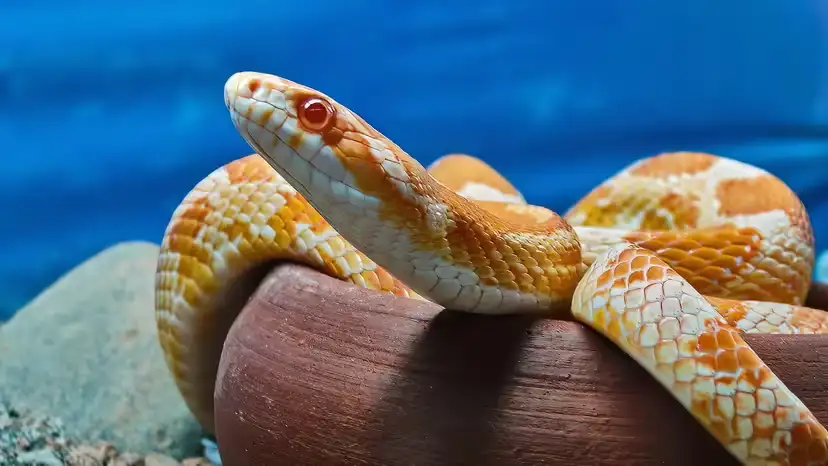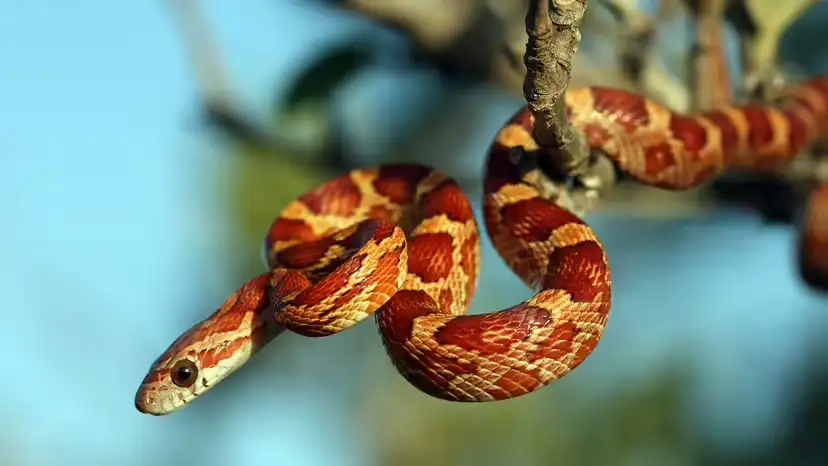Common names: Corn snake / Red rat snake
Scientific name: Pantherophis guttatus
Best for: Beginners (docile, easy to feed, hardy)
Bonus: huge variety of morphs from budget-friendly to premium (e.g., Palmetto, Scaleless, Snow, Amel, Anery, Caramel, Hypo, Motley/Stripe)
Corn snakes are popular because they’re gentle, manageable in size, easy to keep, and widely available from captive-bred stock in a rainbow of patterns. In the wild, they’re also rodent-control specialists, benefiting farms and grain stores.

Corn snakes are easy to take care of, and their patterned scales sometimes resemble variegated corn (sometimes called Indian corn).
Native range: Southeastern & Mid-Atlantic USA (southern New Jersey to Florida Keys; into the Carolinas, Kentucky, Tennessee, Gulf states)
Typical adult size: 90–140 cm (3–4.5 ft); rarely >1.7 m (5.5 ft)
Wild coloration: orange-tan with black-edged red blotches; checkered black-and-white belly (a likely origin of the name “corn snake”)
Venom: Nonvenomous constrictor (kills prey by cutting off blood flow/breathing)
Ecology: barns, abandoned buildings, field–forest edges; excellent climbers and burrow raiders (birds/eggs/rodents/frogs/lizards)
People often confuse harmless corn snakes with venomous copperheads. Use this quick comparison:
| Feature | Corn Snake (P. guttatus) | Copperhead (Agkistrodon contortrix) |
|---|---|---|
| Venom | Nonvenomous | Venomous pit viper |
| Pupil | Round | Vertical slit |
| Head shape | More rounded | Triangular/wedge |
| Dorsal pattern | Saddle/oval blotches | Hourglass crossbands |
| Behavior | Tail-vibrating “buzz” mimicry; usually flees | True viper threat display; can strike |
Tip: Don’t handle unknown snakes. Observe, identify, then give space.
Temperament: generally calm and handleable
Feeding: readily accept frozen-thawed mice; low refusal rate
Hardiness: tolerant of normal household ranges with proper gradients
Size: substantial but not overwhelming
Availability: captive-bred, many morphs and price points

While most corn snakes do their hunting at ground level, some of the reptiles take to the trees in search of prey, like this adult corn snake in the Lower Florida Keys.
Adult minimum: at least a 20-long (≈ 30" × 12" × 12" / 76 × 30 × 30 cm); better: 36–48" length (e.g., 40B ~ 90 × 45 × 45 cm)
Juveniles: smaller tubs/terrariums are fine; upgrade as they grow
Security/ventilation: escape-proof lid, good airflow
Furnishings: two hides (warm & cool sides), climbing branches/vines, textured décor, water bowl big enough for soaking, suitable substrate
Warm side surface: 82–86°F (28–30°C)
Cool side: 72–75°F (22–24°C)
Night: slight drop OK; not below 68°F (20°C)
Humidity: 40–60% (offer a humid hide with damp moss during shed)
Heating: heat mat/panel with thermostat or overhead heat; no hot rocks
Lighting: UVB not required; low-output UVB (2–5%) can support circadian rhythm/general health. Provide 10–12 h day length.
Good options: aspen shavings, coco fiber/chips, paper
Avoid: cedar/pine (aromatic oils—respiratory/hepatic risk)
Maintenance: spot-clean daily, change water daily, deep clean every 2–4 weeks
Diet: frozen-thawed mice sized so the prey’s widest point ≈ snake’s widest body point
Frequency:
Hatchlings/juveniles: every 5–7 days
Subadults: every 7–10 days
Adults: every 10–14 days (adjust to body condition)
After feeding: limit handling for ~48 hours to reduce regurgitation stress
Support the body, move slowly, don’t grab the head. Short, positive sessions build trust. Temporary refusals can occur after moves or pre-shed.
Common issues:
RI (respiratory infection): bubbles/wheezing—check temps/humidity; see a reptile vet
Stomatitis: mouth redness/discharge
Mites: tiny moving specks; treat and disinfect
Retained shed: add humidity/humid hide
Obesity: adjust meal size/intervals
Quarantine: new arrivals 60–90 days with dedicated tools
Lifespan: 15–20 years typical; 30+ years documented
Legal note: Always verify local regulations/permits. Buy from legitimate captive breeders; avoid wild-caught animals.
Seasonality: northern populations brumate; pairing in spring
Clutch: 10–30 eggs; incubation ~28–29°C for ~55–65 days
Genetics: corn morphs involve recessive/dominant/codominant traits; avoid inbreeding and consider welfare with extreme traits (e.g., Scaleless)
Palmetto (white base with confetti micro-spots; premium)
Amel (Albino), Anery (Blackless), Snow (Amel+Anery), Caramel, Hypo, Bloodred, Scaleless, Motley/Stripe
Pricing depends on genetics, stability, pattern quality, rarity
Requires consistent care (heat/humidity, cleaning, regular feeding)
Must accept feeding rodents (frozen-thawed recommended)
Supervise minors; consider household preferences and allergies
Escape-proof terrarium/tub (adult ideally ≥ 36–48" length)
Thermostat + heat mat/panel or heat lamp
Dual thermometer/hygrometer (or separate instruments)
Two hides (warm & cool)
Climbing branch/vine + soaking water bowl
Substrate (aspen/coco/paper)
Frozen-thawed mice + feeding tongs
Reptile-safe disinfectant
Quarantine tub for new arrivals/medical needs
Are corn snakes likely to bite?
They’re generally docile. Any snake may defensively nip if frightened—proper handling minimizes risk.
Do they need UVB?
Not required, but low-level UVB can support circadian rhythm and overall wellbeing. Correct temperature gradients matter most.
Why feed frozen-thawed rather than live?
It’s safer (prey can injure snakes), cleaner, more humane, and easier to portion.
How often do I clean? Will it smell?
Spot-clean/water change daily, deep clean 2–4 weeks. Good ventilation and prompt waste removal keep odors minimal.
Can I cohab corn snakes?
Not recommended. Single housing avoids injuries, food competition, and disease transmission.
animal tags: corn snake
We created this article in conjunction with AI technology, then made sure it was fact-checked and edited by a Animals Top editor.